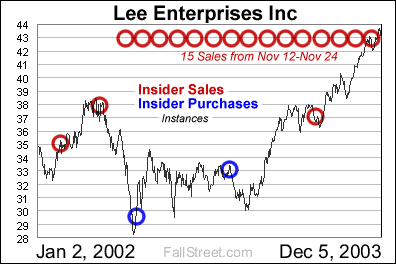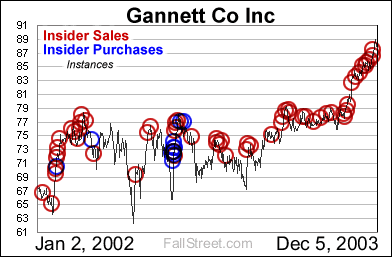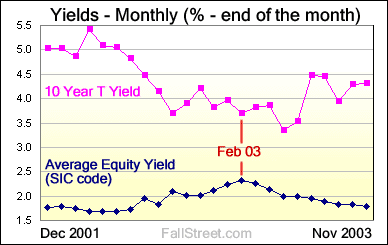December 8, 2003
Visions of Dividends Not Enough To Stop Corporate Heads From Dancing To the Exits
What do Kellogg Company and Masco Corporation have in common? Leading into 2003 each company had increased their annual dividend payout for more than 40-years in a row. What do HJ Heinz Company and Illinois Tool Works Incorporate have in common? Leading into 2003 each company had increased their annual dividend payout for more than 30-years in a row. What do all four of these companies have in common? Each stock struck a new 52-week high last Friday, and insiders have been selling more shares than they have been buying during the last 6-months.
Do Insider Sales Mean Anything?
Top U.S. corporate executives sold $42.98 in stock for every $1 of stock purchased in November (Thomson Financial). This was down from the $59 ratio struck in October, but, for the seventh month in a row, still well above the $20 mark (a level generally regarded as ‘bearish’). To market bulls this data can easily be ignored. After all, Mr. Dell and Mr. Bezos are selling because they own so many shares and/or because they want to diversify, not because they are not optimistic about their company’s prospects. By contrast, people that are not bullish on the markets point out what is obvious -- that if insiders are selling they have found a better use for their money.
Suffice it to say, insider dealings have never been an accurate tool when it comes to predicting the immediate direction of the stock markets. Rather, some studies have shown that insider dealings usually predict the direction of the markets 6-months out. Speculation aside, what can be said is that since executives that buy/sell stock are privy to the inner workings of the company that these transactions are worth monitoring/studying on a company by company basis.
Push Into Dividend Stocks Sparks Insider Selling
Thanks to Bush’s dividend focused tax package and the Fed bullying bond bears, the climate in 2003 is proving beneficial for dividend stocks. To be sure, along with the above mentioned companies countless other companies that regularly pay dividends – including currently overvalued Wish List company Bowl America – have seen spectacular share price gains this year.
Even so, it should be remembered that stock gains can be reversed as quickly as they are made; that a solid dividend history hardly makes a company a smart purchase at any price. For example, consider Lee Enterprises (which is also a member of the elite 40+ years of dividend increases club.)
Make no mistake about it, the 113 year old Lee, which deals in newspapers, is a cash cow. However, with the company trading at more than 20 times free cash flow and earnings, arguing that a 1.68% dividend yield is attractive becomes almost silly. Indeed, with Lee shares rallying more than 40% from lows set in March, mentioning 1.68% in any context is absurd.
 |
Although Lee insiders are not an active bunch, a recent spat of selling suggests that insiders are growing more comfortable at locking in gains. As per the above chart, the last two purchases were for a combined 5,000 shares, while the last 16 sells have been for 179,000 shares. In the case of Lee, insider selling from 5 different individuals does not guarantee a weaker stock price in the future, but when looking at historical instances of insider selling it does suggest that executives are bearish on the stock.
A larger competitor of Lee’s, Gannett, has a more active group of insiders. Again, the trend does not foretell of a weakening stock price, but merely suggests that insiders are turning increasingly bearish.
 |
In short, companies like Lee and Gannett have rallied extra strongly in 2003 (or above any correlation to corporate performance) largely because of Bush’s new dividend tax rules. Elongating this speculation, insiders could be selling now either because they believe interest rates are headed higher (making their sub 2% div yields less attractive) or because they fear their stock is being pushed up by unsustainable speculative forces. Yet another possibility for increased selling from the likes of Gannett’s Chairman, Mr. McCorkindale, is that he felt the need to sell roughly $14 million in stock since November 2003 because he wants to build an addition onto his bungalow, but I have my doubts.
The Double D’s and AT&T
Two more companies - Diebold Inc. and Dover Corp – are also members of the 40+ years of increased annual dividends club. These attractive companies generate solid free cash, and are certainly worthy of investor consideration. But alas, like Lee and Gannett, both Diebold and Dover have dividend yields below 2%, both recently hit 52-week highs, both are trading with a historically rich set of valuations, and both have more insider selling than buying during the last 6-months.
One dividend notable that is worthy of investor consideration today is AT&T. Despite living in a volatile and somewhat unpredictable industry, AT&T is likely to have the means to raise its dividend next year. Over the last 6-months there have been 6 instanced of insider buys versus 2 sells (25,000 shares purchased versus 87,000 shares sold).
Conclusion
While hardly the gospel in predicting stock market movements, on a company to company basis studying dividend trends and insider sentiment can prove insightful. For example, further tax loss selling and continued insider buying could make a company like AT&T (nearly a 5% div) worth investigating by the end of 2003. By contrast, no set of events – save acquisition developments or weaker stock prices – are likely to make yield laggards like Lee or Gannett attractive anytime soon.
Granted, if interest rates do not rise in 2004 owning solid dividend paying companies could prove advantageous; on the one hand your dividend income will be taxed less, and on the other hand potential paper losses could be limited (even a 1.68% yield is more attractive than 0% in a down market.)
That said, the big question worth grappling these days is, in fact, interest rates. More than a simple speculation, any upshot in interest rates would make corporate dividends even less attractive.
 |
Given that many of the most reliable dividend success stories have rallied strongly in 2003, and yields are well below the 10-Year Treasury bond, it is not surprising that insiders have been selling more stock than they are buying. Quite frankly, whereas the investing public is likely acting irrationally by concluding that risky stocks are worth owning instead of bonds, cash, or gold, insiders have been wisely selling into strength since April.
In short, and the tax benefits of dividend income in 2004 notwithstanding, many insiders seem content to step out of today’s marketplace because the stock market rally could prove to be an apparition if interest rates rise sharply and/or stock prices begin to mirror corporate performance more closely. And while corporate executives cashing in $4.5 billion worth of their own companies' shares in November (or double the five-year monthly average) doesn’t necessarily mean stock prices are doomed, it does mean that many of the individuals that dictate dividend policies are not dancing to the dividend tax cut song any longer.
BWillett@fallstreet.com